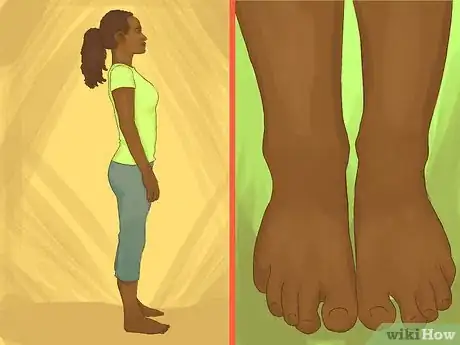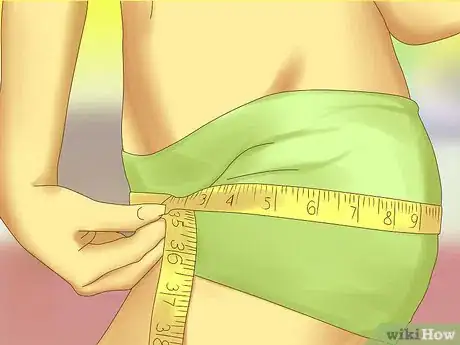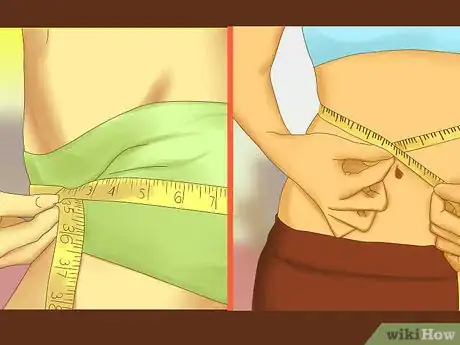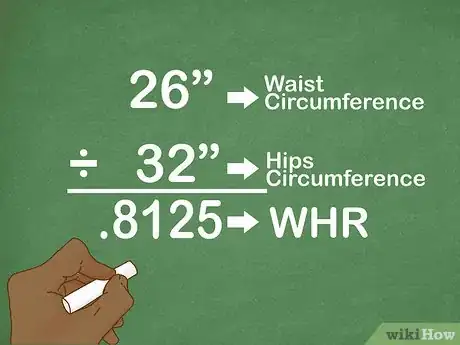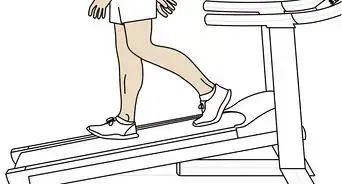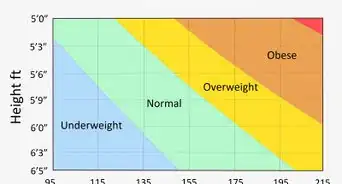This article was co-authored by Melody Sayers, MS, RD, NASM-CPT. Melody Sayers is a Registered Dietitian and NASM (National Academy of Sports Medicine) Certified Personal Trainer. She is the owner of Elevate Your Plate®, a private nutrition counseling and personal training practice, focused on an evidence-based, individualized, realistic, and results-driven approach to improving one's health. With over 8 years of experience, Melody has worked in both the private and public health sectors, helping both individuals and communities achieve milestones in managing their weight and preventing disease. She currently holds a Certificate in Adult Weight Management and a Master of Science in Nutrition, Dietetics, and Food Science from the California State University - Northridge.
wikiHow marks an article as reader-approved once it receives enough positive feedback. In this case, 87% of readers who voted found the article helpful, earning it our reader-approved status.
This article has been viewed 242,828 times.
Your waist to hip ratio is a measure of how fat is distributed around your body. Those with a higher percentage around the waist are sometimes considered "apple-shaped," while those with bigger hips are often noted as "pear-shaped." Women with a waist-to-hip ratio of 0.8 or less and men with a ratio of 0.9 or less are considered "safe." A WHR of 1.0 or higher, for either gender, is considered "at risk" for overweight-associated health problems. Knowing your hip-to-waist ratio can help you gauge your progress for fitness or dieting routines and can keep you aware of your health.[1] But make sure to see a doctor if you have any worries and keep in mind that this is only one measurement out of many possible ones.
Steps
Measuring Yourself
-
1Get a tape measure. The only way to accurately measure around your body is with a flexible, wrap-able tape measure.
- For professional results, which are not necessary for home testing, the World Health Organization suggests stretch-resistant tape with 100g of tension.[2]
-
2Stand up straight with your body relaxed and feet close together. Don't slouch or lean, as this can throw off the measurement. You also don't want to hold your breath or suck in your stomach, as this will give an inaccurate reading.[3]
- You should be wearing very little or no clothing. Get your measurements as close to the skin as possible.
Advertisement -
3Make both measurements just as you finish exhaling. This is going to get the most accurate measurement. Try to get the measurement in the space between finishing to exhale and beginning another inhalation.[4]
-
4Wrap a tape measure around the skinniest part of your waist. More often than not this is just above your belly button, up above the knobs of your hip bones. Keep the tape flat against your belly, not kinked or twisted. You don't want to squeeze or pull, just get a snug measurement.
- Write this measurement down as "Waist Circumference." For an example, say this is 26"
- It does not matter if you use inches or centimeters, so long as you use the same measurement for your hips, too.[5]
-
5Use the tape measure around the widest part of your hips. This is frequently the widest part of your butt, just below where your thighs hinge. Wrap your tape measure, again trying not to kink, twist, or pull tightly on it.
- Write this measurement down as "Hip Circumference." For an example, say this is 32"
- If you measured in inches for the waist, use inches again here. If you used centimeters before, use centimeters now, etc.
-
6Take both measurements a second time to account for any changes from breathing. This is the clinical standard, but if you're just curious for a rough figure you can skip this step. Doctors do this to ensure they get the most accurate reading possible.
-
7Divide your waist circumference by your hip circumference. The result is your waist-to-hip ratio, or WHR. Simply pull up a calculator and divide the waist measurement by the hip measurement:
- For an example, assume your waist circumference is 26" and your hip circumference is 32"
- WHR = .8125
Understanding Your Waist to Hip Ratio
-
1Aim for a WHR lower than .90 if you are a man. A healthy male generally has slightly bigger hips than waist, but there should not be a huge difference. This is why the ratio for a healthy male is close to 1. Note, however, that small changes make a big deal for men -- any ratio above .95 poses a health risk. Staying at .90 or lower is ideal.
-
2Keep your WHR lower than .80 if you're a woman. Women naturally have bigger hips for childbearing, meaning a healthy ratio for women is much lower than for men. This is why their ratio is generally lower -- they are dividing by a bigger hip circumference in general. Anything above .85 is a reason to reexamine diet and exercise habits.[6]
-
3Know that a WHR above 1.0 for men and above .85 for women indicates high health risks. Your waist to hip ratio is a proven indicator of future cardiovascular disease, diabetes, high blood pressure, and gall bladder disease.[7]
-
4Learn the risk factors you need to fight in order to return to a positive WHR. Lowering your waist to hip ratio to a healthy level is largely a factor of diet and exercise. Aiming to eat more fruits and vegetables, lean meats (like chicken, turkey, and fish), and cut back on total food consumption is the best way to fight an unhealthy WHR. You should also consider:
- Quitting smoking
- Walking, running, or biking 30 minutes a day.
- Talking to your doctor about cholesterol or blood pressure medication
- Cutting back on alcohol, soda, and other "empty" calories.[8]
-
5Know that WHR is only one of several tests to determine a healthy weight. While waist to hip ratio is an important indicator of health, it is not the only one you should pay attention to. Use another test, such as your Body Mass Index (BMI), to help put this number in context.
- BMI is a measure of your total body fat, meaning how much of your body is comprised of fat. People with naturally atypical body shapes (very tall or short, broad or skinny, etc.) tend to learn more from BMI than from WHR.
- While not a measure of obesity, you should have blood pressure tests if you're worried about the effects of a poor diet or lack of physical activity.
Expert Q&A
-
QuestionHow often should I take body measurements?
 Melody Sayers, MS, RD, NASM-CPTMelody Sayers is a Registered Dietitian and NASM (National Academy of Sports Medicine) Certified Personal Trainer. She is the owner of Elevate Your Plate®, a private nutrition counseling and personal training practice, focused on an evidence-based, individualized, realistic, and results-driven approach to improving one's health. With over 8 years of experience, Melody has worked in both the private and public health sectors, helping both individuals and communities achieve milestones in managing their weight and preventing disease. She currently holds a Certificate in Adult Weight Management and a Master of Science in Nutrition, Dietetics, and Food Science from the California State University - Northridge.
Melody Sayers, MS, RD, NASM-CPTMelody Sayers is a Registered Dietitian and NASM (National Academy of Sports Medicine) Certified Personal Trainer. She is the owner of Elevate Your Plate®, a private nutrition counseling and personal training practice, focused on an evidence-based, individualized, realistic, and results-driven approach to improving one's health. With over 8 years of experience, Melody has worked in both the private and public health sectors, helping both individuals and communities achieve milestones in managing their weight and preventing disease. She currently holds a Certificate in Adult Weight Management and a Master of Science in Nutrition, Dietetics, and Food Science from the California State University - Northridge.
Registered Dietician & Personal Trainer There are no specific guidelines regarding the frequency of taking measurements, such as the waist-to-hip ratio. It is always best to conduct any assessments prior to starting an exercise program in order to obtain baseline data. Once you have noticed visual results as a result of your exercise efforts or you feel as though your clothes fit differently, you can then repeat the measurement. It is important to use the same measuring tool(s) in order to ensure your results are accurate. Taking body measurements is a great way to monitor your progress.
There are no specific guidelines regarding the frequency of taking measurements, such as the waist-to-hip ratio. It is always best to conduct any assessments prior to starting an exercise program in order to obtain baseline data. Once you have noticed visual results as a result of your exercise efforts or you feel as though your clothes fit differently, you can then repeat the measurement. It is important to use the same measuring tool(s) in order to ensure your results are accurate. Taking body measurements is a great way to monitor your progress.
Warnings
- Waist to hip ratio is not an all-conclusive test. While it is a good measurement to take, it alone can not tell you if you are healthy or not. It is just a small part of a doctor's examination.⧼thumbs_response⧽
Things You'll Need
- Flexible measuring tape
- Pen or pencil
- Notebook
- Calculator
References
- ↑ Melody Sayers, MS, RD, NASM-CPT. Registered Dietician & Personal Trainer. Expert Interview. 6 May 2020.
- ↑ http://apps.who.int/iris/bitstream/10665/44583/1/9789241501491_eng.pdf
- ↑ http://www.memorialcare.org/events-education/waist-hip-ratio-calculator
- ↑ http://apps.who.int/iris/bitstream/10665/44583/1/9789241501491_eng.pdf
- ↑ http://www.bmi-calculator.net/waist-to-hip-ratio-calculator/waist-circumference.php
- ↑ http://apps.who.int/iris/bitstream/10665/44583/1/9789241501491_eng.pdf
- ↑ https://www.nhlbi.nih.gov/health/educational/lose_wt/risk.htm
- ↑ https://www.nhlbi.nih.gov/health/educational/lose_wt/risk.htm
About This Article
Your waist-to-hip ratio is a good measurement of how fat is distributed around your body. To calculate the ratio, start by standing in a relaxed posture with your feet close together. Take a breath and exhale fully. Wrap a tape measure around the skinniest part of your waist and write down the measurement. Then, use the tape measure to measure the widest part of your hips, and write down that measurement. Divide the first measurement by the second measurement to get your ratio. For example, if you have a 22-inch waist and 36-inch hip measurement, you would divide 22 by 36 and get 0.61. Therefore, your waist-to-hip ratio would be 0.61. Generally, a waist-to-hip ratio should be lower than 0.90 for men and lower than 0.80 for women. To learn more about what waist-to-hip ratios can be used for, keep reading!


